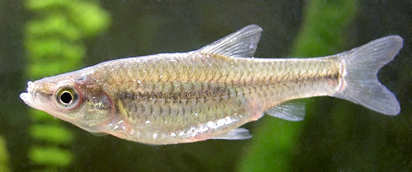Deadly Parasite Could Endanger UK Salmon and Trout Populations
 |
Research is being led by Dr Rodolphe Gozlan |
Stocks of the UK’s Atlantic salmon along with varieties of domestic Brown trout could be under threat from a deadly parasite according to research led by BU expert Dr Rodolphe Gozlan and published in the International Journal of Parasitology.
Dr Gozlan, Associate Professor in Conservation Ecology within BU’s School of Conservation Science, believes the disease is a rosette agent or parasite first identified in the UK in 2005. The agent - Sphaerothecum destruens – was originally found in the US and is closely associated with ‘invasive’ fish species including topmouth gudgeon and could prove deadly to native salmonids (Atlantic salmon, brown trout).
Dr Gozlan and his colleagues from the University of California-Davis, State University of New York, the UK’s Centre for Ecology and Hydrology and Cardiff University have found the first record of the new infective parasite rosette agent outside North America.
In his previous research (Nature, 2005), Dr Gozlan initially found that the parasite poses a severe threat to some freshwater fish species in Europe. The latest findings have serious implications in understanding the potential risk posed by the association in the UK of this disease, the rosette agent, with invasive fish species.
North American isolates of the rosette agent have been shown to cause both high morbidity and mortality in various salmonid species including Atlantic salmon, brown and rainbow trout. Analysis of the European strain indicates a degree of isolation between European and North American rosette agent populations.
“Unlike in the US, the occurrence of this agent in invasive fish presents a major risk of spread from wild invasive populations to sympatric populations of susceptible native fish,” said Dr Gozlan. “As such it represents a risk for fisheries and commercial aquaculture, as movement of fish for stocking purposes is common practice.”
Dr Gozlan and his colleagues say more work is required to determine the extent of the threat to UK and European fish diversity. They have already observed the rapid demise of the sunbleak (Leucaspius delineatus) in parts of Europe in the last forty years following the spread of a healthy carrier – the Asian topmouth gudgeon - the most invasive fish species in Europe. As a result, the sunbleak species is now on the European list of threatened freshwater fishes.
Scientists at BU have so far found 26 populations of topmouth gudgeon across England and Wales in rivers, enclosed lakes and sites connected to the river network. Catchments at risk from invasion include the Kent, Yorkshire Ouse, Trent, Thames, Medway, Itchen, Test and Severn.
“The new parasite has also been shown to affect other UK freshwater fish such as bream, carp and roach so there is an urgent need to develop more sensitive detection tools of the rosette agent if responsible authorities want a chance to control its spread and limit future outbreaks,” concluded Dr. Gozlan.
Article proofs can be found at the Science Direct website link shown below.

Topmouth Gudgeon Pic: Dr Rudy Gozlan
- Centre for Conservation Ecology & Environmental Change
- Staff profile for Dr Rudy Gozlan
- Science Direct

18/06/09
